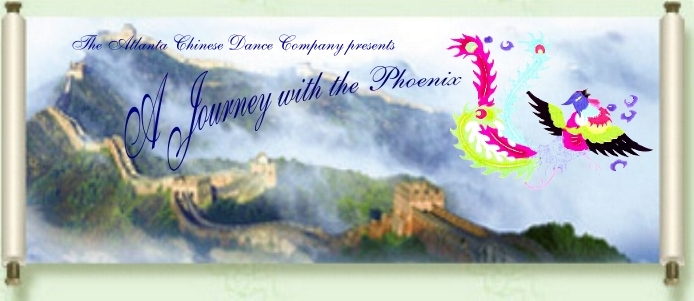|
General
Information
|
|
Saturday, March 9. 2002 at 7:30 PM
Sunday, March 10, 2002 at 2:00 PM
Gwinnett Civic and Cultural Center
(directions)
Ticket: $ 15.00 - General
($10.00 - Student)
|
For information or wish to be on our mailing list, please contact
Atlanta Chinese Dance Company
(770)449-9953
atlantachinesedance@comcast.net
http://www.atlantachinesedance.org
|
The
all-new production of A Journey with the Phoenix is inspired by
the well-known Chinese dance specialist Hwee-Eng Y. Lee, whose eclectic
background ranges from Chinese dance to ballet to modern dance. In
October 2000, Ms. Lee led the company in the critically acclaimed performance
of the Bamboo Forest of Yunnan, a work created by the partnership of Lee
and Tang Yebi, a professor of the Yunnan Institute of Nationalities’ Dai
dance department. The enthusiastic sold–out crowd was made up not only
of Chinese, but of an international audience. This
year, for the first time, Ms. Lee has created a production
with a storyline. The story resembles the enchanting Christmas classic, The Nutcracker.
This is the first attempt to create a dance production with the purpose of describing the Chinese heritage to the general
public from a Chinese-American's point of view.
[Top of page]
|
|
Synopsis of
A
Journey with the Phoenix
Written by Kerry Lee
 It
is Chinese New Year, and Meihua, meaning "American Chinese," is celebrating
the lunar holiday with her Chinese-American friends at the local Chinatown.
They are watching a group performing traditional Chinese opera, and the
young girls struggle for a good view amidst a crowd. Being as young as they
are, they soon fall asleep. Meihua starts to dream. A phoenix, a mythical
bird popular in the Chinese culture, flies beside her. She says, "My name
is Feng Huang ("phoenix" in Chinese), and I have come from the Orient to
take you on a journey to the land of your ancestors." Meihua is very
amazed, and agrees to embark on the long journey. It
is Chinese New Year, and Meihua, meaning "American Chinese," is celebrating
the lunar holiday with her Chinese-American friends at the local Chinatown.
They are watching a group performing traditional Chinese opera, and the
young girls struggle for a good view amidst a crowd. Being as young as they
are, they soon fall asleep. Meihua starts to dream. A phoenix, a mythical
bird popular in the Chinese culture, flies beside her. She says, "My name
is Feng Huang ("phoenix" in Chinese), and I have come from the Orient to
take you on a journey to the land of your ancestors." Meihua is very
amazed, and agrees to embark on the long journey.
As they arrive in Beijing, Feng Huang and Meihua come
across a group of young girls also celebrating Chinese New Year. They greet
her, and invite her to join in the traditional ribbon dance. Afterward, Feng Huang asks Meihua, "Did you know that China has a very long
civilized history?" Meihua shakes her head. "Well," Feng Huang replied,
"China had many dynasties, like the Tang, Song, and Qing dynasties." A
group of goddesses fly from the sky. They are from the Tang dynasty. Each
of them plays an intricately designed instrument known as the pipa.
There are other ladies, who dance with the
elegant water sleeves.
Afterward, Feng Huang asks Meihua, "Did you know that China has a very long
civilized history?" Meihua shakes her head. "Well," Feng Huang replied,
"China had many dynasties, like the Tang, Song, and Qing dynasties." A
group of goddesses fly from the sky. They are from the Tang dynasty. Each
of them plays an intricately designed instrument known as the pipa.
There are other ladies, who dance with the
elegant water sleeves.
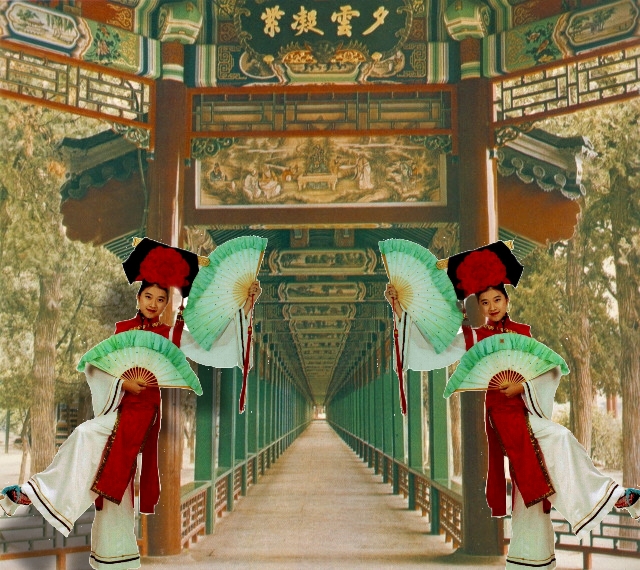 Another
group is preparing to go to war. "This is only the Tang dynasty." Feng
Huang says, "There are many other dynasties as well." With that, she
introduces the Song and Qing dynasties, with each having their specialties.
Then Meihua asked, "What happened to China after the downfall of the
dynasties?" Feng Huang then presents China in the post World War II era.
In that time period, there were many poor families who lived a miserable
life. Another
group is preparing to go to war. "This is only the Tang dynasty." Feng
Huang says, "There are many other dynasties as well." With that, she
introduces the Song and Qing dynasties, with each having their specialties.
Then Meihua asked, "What happened to China after the downfall of the
dynasties?" Feng Huang then presents China in the post World War II era.
In that time period, there were many poor families who lived a miserable
life.
 The
white-haired girl is an example. She, though, was lucky. She was
eventually saved and reunited with her lover. Meihua is touched by her
courage, and presents the white-haired girl with a scarf to cover her hair.
Originally from the Shanghai Ballet School
(premiere performance in
1965), White-haired
Girl is
a well-known Chinese contemporary ballet describing the arduous life of a
young girl living in the World War II era. This
is the first Chinese ballet based on a
real-life story in China. White-haired girl-Kerry Lee; Da Chun (the
soldier)-Xiao Chen of the Atlanta Ballet. The
white-haired girl is an example. She, though, was lucky. She was
eventually saved and reunited with her lover. Meihua is touched by her
courage, and presents the white-haired girl with a scarf to cover her hair.
Originally from the Shanghai Ballet School
(premiere performance in
1965), White-haired
Girl is
a well-known Chinese contemporary ballet describing the arduous life of a
young girl living in the World War II era. This
is the first Chinese ballet based on a
real-life story in China. White-haired girl-Kerry Lee; Da Chun (the
soldier)-Xiao Chen of the Atlanta Ballet.
Feng
Huang says, "Now that you have learned about Chinese history, I would like
to introduce you to the present." They fly to a small village. A young Han
girl carries a "biandan" to sell goods. (A "biandan", a
tool used to carry items, is a stick, with goods on either end. The center
is placed on the shoulders.) Meihua stops to buy a fan and hat from her.
She then watches as the mountain girl cleverly outwits the monkeys who have
raided her goods. Then Feng Huang says, "Your homeland is a very diverse
place. There are fifty-six minority ethnic
groups here." Meihua asks, "What ethnic group
am I from?" 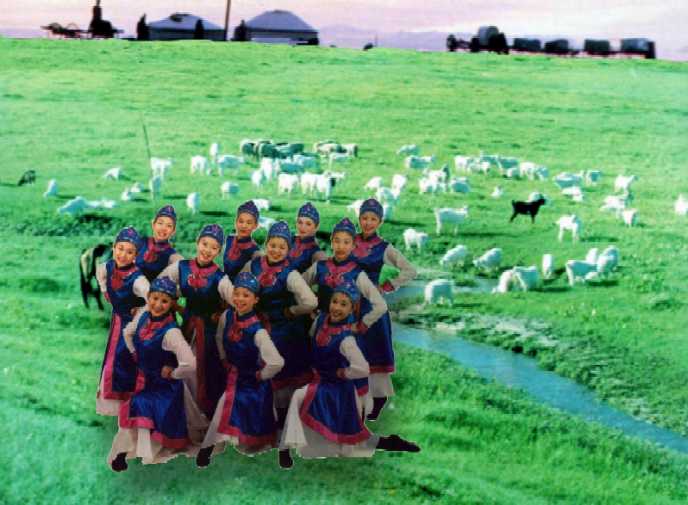 "You
are a descendant of the Han ethnic group, the majority ethnic group here." Feng
Huang introduces a few of the minorities: the Ami in Taiwan, the Dai in
Yunnan, the Wei Wu Er in Xin Jiang, the Li in Hainan, the Tibetans in Tibet, and
the Mongols in Inner Mongolia. Each group performs their authentic dance.
Meihua is intrigued by the fact that each group is so unique. "It is time
for you to return," Feng Huang says. She takes Meihua back to Beijing,
where all of the ethnic groups about which she has learned say farewell to her.
She is sad to leave them, but she is eager to return to her friends in America. "You
are a descendant of the Han ethnic group, the majority ethnic group here." Feng
Huang introduces a few of the minorities: the Ami in Taiwan, the Dai in
Yunnan, the Wei Wu Er in Xin Jiang, the Li in Hainan, the Tibetans in Tibet, and
the Mongols in Inner Mongolia. Each group performs their authentic dance.
Meihua is intrigued by the fact that each group is so unique. "It is time
for you to return," Feng Huang says. She takes Meihua back to Beijing,
where all of the ethnic groups about which she has learned say farewell to her.
She is sad to leave them, but she is eager to return to her friends in America.
Meihua's friends find Meihua in the street and wake her
up. As she wakes up, she remembers her wonderful journey.
[Top of page]
|
Highlights of
A Journey with the
Phoenix
|
Watching Chinese Opera on the Street
 This
dance depicts a group of Han (majority ethnic group in China)
Chinese-American children watching Chinese opera on the street in front of
their local Chinatown. They happily compete
for a space in the audience while imitating the performers. Being as
young as they are, they inadvertently fall asleep in the process. This
dance comes from the Shanxi Province Children's Arts Troupe. This
dance depicts a group of Han (majority ethnic group in China)
Chinese-American children watching Chinese opera on the street in front of
their local Chinatown. They happily compete
for a space in the audience while imitating the performers. Being as
young as they are, they inadvertently fall asleep in the process. This
dance comes from the Shanxi Province Children's Arts Troupe.
Feng Huang Arrives in Meihua's Dream
In Meihua's dream, Feng Huang, a phoenix,
flies to see her from heaven. Sovereign of all birds, the phoenix has the
head of the golden pheasant, the beak of the parrot, the body of the
mandarin duck, the wings of the roc, the feathers of the peacock and the
legs of the crane; gloriously beautiful, it reigns over the feathered
world.
Feng Huang
takes Meihua to explore
her heritage.
Dun Huang: Dance
of the Pipa
Dun Huang music and dance developed during
the Tang dynasty, one of the richest periods in Chinese Arts history. The
classical Dun Huang Dance style shows Indian influence, which occurred
during the introduction of Buddhism into China. The images of the dancers
on mural paintings from the past illustrated the unique Dun Huang style in
Chinese dance history. The pipa was a popular instrument during the time
period. (See picture in the Synopsis: The picture was taken at
the Atlanta's Woodruff Arts Center, where the ACDC performed for the 2002
Chinese New Year.)
Dance of the
Manchurian Concubines
In this award-winning piece, two beautifully
gowned Manchurian court ladies with elaborate Manchu-style headdresses and
high platform shoes sway through the Imperial Palace (Forbidden City)
while beating the drum for the entertainment of the emperor. (See
picture in the Synopsis)
Chinese Contemporary Ballet-Excerpt from White-haired Girl
 White-haired
Girl is a well-known Chinese contemporary ballet describing the arduous
life of a young girl living in the World War II era. Because her father
could not pay off a debt on the eve of the Chinese New Year, the young
girl was forced to become a slave for her landlord. She eventually ran
away and hid in a cave, and everyone assumed she was dead. As a result of
the lack of sunlight in the cave, her hair turned white. Meanwhile, her
lover enlisted in the army. One day, he led his troops into her cave,
believing that she was a ghost. Eventually, they recognize each other, and
are happily reunited. (Image on the left: Xiao Chen of Atlanta Ballet
works with Kerry Lee in a rehearsal.) White-haired
Girl is a well-known Chinese contemporary ballet describing the arduous
life of a young girl living in the World War II era. Because her father
could not pay off a debt on the eve of the Chinese New Year, the young
girl was forced to become a slave for her landlord. She eventually ran
away and hid in a cave, and everyone assumed she was dead. As a result of
the lack of sunlight in the cave, her hair turned white. Meanwhile, her
lover enlisted in the army. One day, he led his troops into her cave,
believing that she was a ghost. Eventually, they recognize each other, and
are happily reunited. (Image on the left: Xiao Chen of Atlanta Ballet
works with Kerry Lee in a rehearsal.)
Dai Umbrella Dance
This piece was choreographed by Tang Yebi,
the choreographer of Bamboo Forest of Yunnan. This is the
first time the ACDC presents the piece to the public.
 Dai Dance: In Pursuit of the Fish Dai Dance: In Pursuit of the Fish
This award-winning piece is a Dai folk dance
mimicking animal movements. It portrays a fisherman trying to chase a
goldfish. The fish is a significant animal to the Dai ethnic group, due
to the importance of the river in their daily lives.
Tibet Dance: Lucky Drum Dance
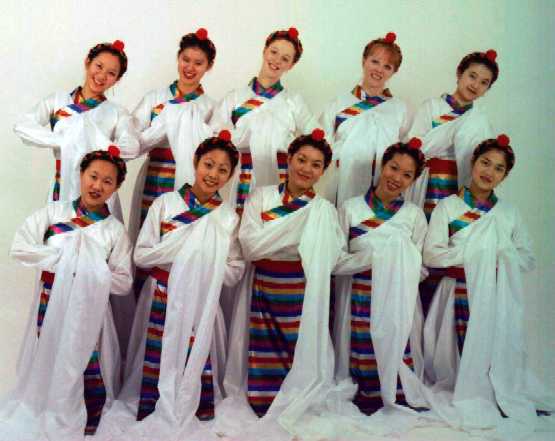 Most
Tibetans live in the western part of China in places like Tibet, Qing Hai,
Yunnan, Gan Shu, and Si Chuan. Typically, their clothing includes a
multi-colored apron and long sleeves. They sometimes only wear one sleeve
because the weather can change rapidly in a single day. In this dance, the
Tibetan girls walk down from the Himalayan Mountains. Most
Tibetans live in the western part of China in places like Tibet, Qing Hai,
Yunnan, Gan Shu, and Si Chuan. Typically, their clothing includes a
multi-colored apron and long sleeves. They sometimes only wear one sleeve
because the weather can change rapidly in a single day. In this dance, the
Tibetan girls walk down from the Himalayan Mountains.
Mongolian Dance:
Grassland Girls
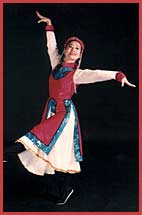 Mongolians live on the vast prairie in the
northern part of China. Many of the people live as shepherds. Their
traditional culture has a close relationship with sheep, horses and
eagles. The dance is characterized by vigorous and energetic movements.
Some of the movements are intended to evoke the image of horseback-riding.
(See also picture in the Synopsis). Mongolians live on the vast prairie in the
northern part of China. Many of the people live as shepherds. Their
traditional culture has a close relationship with sheep, horses and
eagles. The dance is characterized by vigorous and energetic movements.
Some of the movements are intended to evoke the image of horseback-riding.
(See also picture in the Synopsis).
and many more.
[Top of page]
|
|
The Legend of
Phoenix
Adapted from "Dragon and Phoenix" by Mr. Du
Feibao, http://www.chinavista.com/experience/dragon/dragon.html
The dragon and the phoenix are the principal motifs for
decorative designs on the buildings, clothing and articles of daily use in
the imperial palace. The Chinese phoenix exists only in legends and fairy
tales. Sovereign of all birds, it has the head of the golden pheasant, the
beak of the parrot, the body of the mandarin duck, the wings of the roc, the
feathers of the peacock and the legs of the crane; gloriously beautiful, it
reigns over the feathered world. An early design of the phoenix can be seen
on a silk painting discovered in a tomb of the Warring States Period
(475-221 B.C.) near Changsha in Hunan Province. The dragon and the phoenix
often served in classical art and literature as metaphors for people of high
virtue and rare talent or, in certain combinations, for matrimonial harmony
or happy marriage. As an important part of folk art, lanterns, paper cuts
and phoenix dances are still highly popular on festivals among the people of
all localities.
|
 |
 |
|
 |
|
Early design of the
Phoenix |
Character |
Paper cut |
Lantern |
|
|
[Top of page]
The Atlanta Chinese Dance
Company
The Atlanta Chinese Dance Company has an eleven year
history, in which they have never failed to serve both the Chinese and
non-Chinese communities in Atlanta. Founded by Ms. Lee, the company trains
over seventy dancers, aged five to fifty, who are residents of the metro-Atlanta
counties. The majority of them have many years of performing experience
with the company. The company has appeared in the Opening and Closing
ceremonies of the 1996 Centennial Olympic Games. They have also appeared
in the Chinese variation of Atlanta Ballet’s holiday production of The
Nutcracker. In addition to the Bamboo Forest of Yunnan, which was
held in the Gwinnett Civic and Cultural Center, the company has presented
performances in such theaters as the Robert Ferst Center for the Arts and the
Rialto Center for the Performing Arts. ACDC has also participated in
Festival of Trees, Decatur Arts Festival, Georgia Tech International Festival,
International Children Day organized by North Fulton County Arts Council,
Chinese New Year festivities at the Chinese Cultural Center and other venues,
City Hall Atrium, King Center, Underground Atlanta, Emory University, World of
Coca-Cola Atlanta, Hunger Walk, Stone Mountain Park, Colony Square, Fernbank
Science Center, Piedmont Park, Centennial Olympic Park, public schools and
private schools, etc.. In addition to performing in Atlanta, the company
has also made an appearance in Knoxville, Tennessee, where they presented a
performance at the Performing Arts Center in Pellissippi State Technical
Community College, and in a few elementary schools near Greenville, South
Carolina.
[Top of page]
|
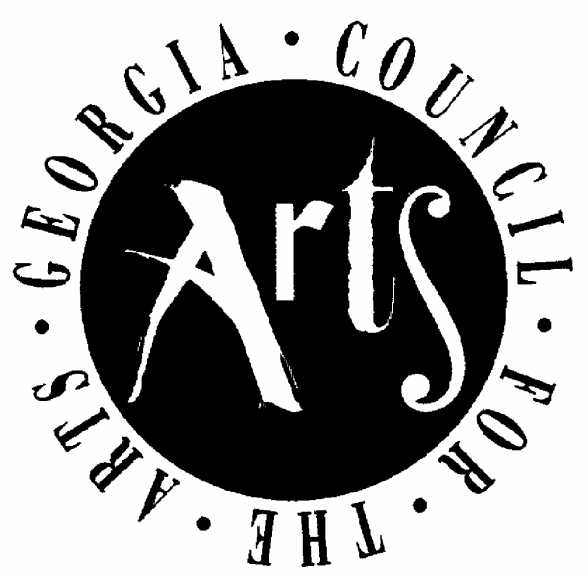 |
This program is
supported in part by the Georgia Council for the Arts through the
appropriations of the Georgia General Assembly. The Council is a
Partner Agency of the National Endowment for the Arts. Additional funding is
provided by the Gwinnett Council for the Arts and various other sponsors. |
|
|
|
